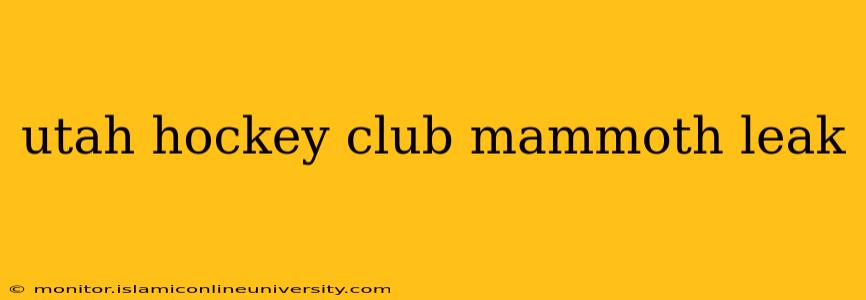The recent data leak involving the Utah Hockey Club Mammoth has sent shockwaves through the hockey community and raised serious questions about data security and player privacy. This incident highlights the vulnerabilities inherent in the digital age and underscores the need for enhanced data protection measures within sports organizations. This article will delve into the details of the leak, its potential impact, and the lessons learned. We will also address some common questions surrounding this event.
What happened in the Utah Hockey Club Mammoth data leak?
While the precise details of the breach remain somewhat unclear due to ongoing investigations, reports suggest a significant amount of sensitive data pertaining to players, staff, and potentially even fans, was compromised. This could include personal information like names, addresses, phone numbers, email addresses, financial details, and possibly even medical records. The leak's origin and the methods used to access the data are still under scrutiny. The scale of the breach is also yet to be fully determined, but it’s clear that the impact could be considerable.
What kind of data was leaked from the Utah Hockey Club Mammoth?
The exact nature of the leaked data is still being investigated and hasn't been fully disclosed publicly. However, based on reports and the typical data held by sports organizations, it is likely to include personally identifiable information (PII) such as names, addresses, contact details, dates of birth, and potentially even financial information related to players' contracts or payments. The concern extends to potentially sensitive medical data related to injuries and treatments, as this information is often held within team databases. The possibility of social security numbers or other sensitive financial records being leaked also adds to the severity of the situation.
How did the Utah Hockey Club Mammoth data leak happen?
The precise method of the data breach remains under investigation, preventing a definitive answer. However, possible scenarios include:
- Phishing attacks: Employees may have fallen victim to phishing emails or other forms of social engineering, granting unauthorized access to the system.
- Malware or ransomware: Malicious software could have been introduced into the team's systems, enabling data exfiltration.
- Exploitation of vulnerabilities: Unpatched security flaws in the team's software or network infrastructure may have been exploited by malicious actors.
- Insider threat: A disgruntled employee or someone with internal access could have been involved.
Determining the root cause is crucial for preventing future incidents.
What are the potential consequences of the Utah Hockey Club Mammoth data leak?
The consequences of this data breach are far-reaching and could include:
- Identity theft: Leaked personal information could be used for identity theft, resulting in financial losses and reputational damage for affected individuals.
- Financial fraud: Financial details, if compromised, could be exploited for fraudulent purposes.
- Reputational damage: The leak significantly damages the Utah Hockey Club Mammoth's reputation and could erode trust among players, fans, and sponsors.
- Legal ramifications: The team may face lawsuits from affected individuals and regulatory penalties for failing to adequately protect sensitive data.
- Privacy violations: The leak constitutes a serious violation of player and fan privacy, potentially leading to legal repercussions under relevant privacy laws.
What steps should the Utah Hockey Club Mammoth take to mitigate the damage?
The Utah Hockey Club Mammoth needs to take swift and decisive action, including:
- Conducting a thorough investigation: Determine the root cause of the breach to prevent future incidents.
- Notifying affected individuals: Immediately inform players, staff, and fans whose data was compromised.
- Offering credit monitoring and identity theft protection services: Assist those affected in mitigating potential risks.
- Working with law enforcement: Cooperate with authorities in investigating the breach and prosecuting those responsible.
- Improving data security practices: Implement robust security measures to prevent future breaches, including employee training, regular security audits, and strong access control policies.
- Transparency and communication: Maintain open and honest communication with all stakeholders.
This incident serves as a stark reminder of the importance of robust cybersecurity measures for all organizations, especially those handling sensitive personal data. The Utah Hockey Club Mammoth, and other sports organizations, must prioritize data security to maintain the trust of their players, fans, and stakeholders. The full consequences of this leak are yet to unfold, but it's clear that the incident will have long-lasting effects.
